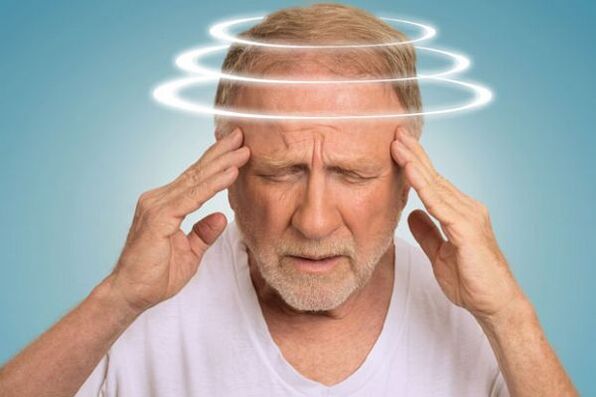
Cervical osteochondrosis is a very common disease that affects both men and women. Moreover, age does not play a special role here. Symptoms of cervical osteochondrosis do not only occur in the elderly, whose pathology is a consequence of the natural aging process. The disease is increasingly occurring in young people and in most cases are themselves to blame.
Causes of pathology
This lesion of the spine is degenerative-dystrophic in nature. That is, pathological changes occur in the vertebrae, as well as in all their structural elements, which can no longer be reversed in later stages. This type of osteochondrosis is considered to be the most dangerous because it results in damage to the main nerve roots and blood vessels that feed the brain. That is, over time, the entire length of the spine ceases to function normally.
The following causes of the disease can be distinguished:
- Lifting and moving heavy objects.
- Significant sports load.
- Improper carrying of weights.
- Long-term adherence to static posture: working with a computer, writing notes, reading books, office work. This is the main reason for young people.
- Genetic factor.
Of course, inflammatory processes in the spine or other parts of the body can also trigger osteochondrosis of the neck. Other causes are not excluded: hypothermia, trauma, surgery.
Classification of symptoms
Thus, spinal treatment should only be performed after the patient has received an accurate diagnosis. To do this, the physician must know the clinical picture of the patient and apply all instrumental examination methods. The patient's symptoms depend on the degree of damage to the body system:
- Brain-side symptoms result from impaired blood circulation due to vascular compression.
- The image of peripheral nerve damage appears due to the compression of nerve roots exiting the vertebral foramen.
- Severe neurological disorders appear in the late stages of disease development due to spinal cord pinching.
You can now consider the main signs of osteochondrosis of the neck in more detail.
The most common symptoms of pathology
Despite the cause contributing to the onset of the problem, the clinical picture is almost always the same. Osteochondrosis of the cervical spine has the following symptoms:
- Painful feelings. They are located in the neck, back of the head and collar area. The pain can also spread to the skeleton’s shoulders, chest, and collarbone. Common migraines are characteristic of osteochondrosis. Gradually, the discomfort becomes aching, chronic. Worsening of the pathology causes shooting pain while moving. The muscles were very tense at the same time. Sometimes this symptom can only be relieved by injection - anesthetic blockade.
- Tinnitus, a stuffy feeling. This is due to a deterioration in the blood supply to the vestibular device.
- Dizziness. It is caused by a lack of oxygen because the inner ear is poorly supplied with blood. This condition is accompanied by uncontrolled irregular movement of students.
- Fainting from which the patient comes out fairly quickly if blood circulation in the affected area improves.
- Feeling of lack of air. The symptom shown is due to irritation of the french nerve. That is, the patient is simply unable to take a deep breath. He also snores and may suddenly stop breathing. Over time, the patient causes shortness of breath and suffocation attacks. Additional oxygen starvation damages brain tissue, which impairs attention and memory.
- Nausea. Sometimes any movement of the body or head is accompanied by vomiting that is difficult to control. The patient's appetite is disturbed and the weight is reduced.
- Vision problems. Cervical osteochondrosis can cause symptoms such as "flies" in the eye or fog, a decrease in severity, a violation of the focus of the gaze. In addition, exercising or wearing glasses may not solve the problem.
- Pressure change. This condition is caused by spasms of the arteries. The patient may even lose consciousness.
- Dry and lumpy feeling in the throat. Sometimes this is the only symptom that says the neck is affected. Therefore, osteochondrosis in this case can be easily confused with other pathologies.
- Temperature rise. This symptom is uncommon. Moreover, it is not the base temperature that changes, but the local temperature. The skin around the neck will be hot and red.
- Limited mobility. The neck seems to be wedged. And when you turn your head, you may also hear an unpleasant crackle and crackle in your neck.
- Weakness in the arms and a burning sensation between the shoulder blades.
- Impaired coordination of movements, which affects the patient's gait.

Some of the signs of cervical osteochondrosis listed above are not specific. This makes it somewhat difficult to diagnose the disease because a person does not turn to professionals in time.
Symptoms of the disease, depending on the extent of its development
Depending on the symptoms observed in the patient, their prevalence and intensity, we can talk about the developmental stage of osteochondrosis of the cervical spine. Each grade has its own characteristics:
- First phase. There are intermittent headaches and discomfort in the neck, shoulders and arms. Mobility is slightly limited. The sensitivity of the skin in the area of the collar may decrease slightly. At this stage, treatment is virtually non-existent as patients do not seek medical attention. Some patients try folk remedies to treat osteochondrosis at home.
- Second stage. The pain in the cervical spine increases, an unpleasant crackling is heard. Severe violations of sensitivity appear in the shoulder as well as in the hands. The headache practically does not go away at this stage, the patient's vision deteriorates, noise occurs in the head and ears, and the purity of the tendon reflexes decreases. As osteochondrosis worsens, shooting pains appear that radiate below the shoulder blade. Here it is no longer possible not to notice the symptoms of the disease and the patient tries to see a doctor. However, it is no longer possible to get rid of defeat completely. Only further development can be slowed down.
- Third stage. Here, the collagen fibers of the disc have already been destroyed, the appearance of the hernal protrusion. The vertebrae are detached and begin to fall out. Even dislocations can occur. The patient has very severe pain in the neck and heart, there are paralysis and paralysis in the upper limbs, the spine is bent. Tendon reflexes are virtually absent at this stage in the development of osteochondrosis. Such a complication of cervical osteochondrosis is spinal cord stroke.
If a person, in consultation with a doctor at home, "saves" from the disease, this behavior can result in disability.
Osteochondrosis of the cervical spine cannot be completely cured, but timely and correct therapy can slow its progression.
What syndromes cause osteochondrosis?
So there are certain symptoms that suggest that a person has a certain syndrome. If at least one sign is missing, there is no need to talk about such a pathological condition.
There are several syndromes that are triggered by cervical osteochondrosis:
- Radicularis. Alternatively, it can be called "cervical radiculitis. "Appears due to pinched nerves. It is characterized by the following symptoms: the presence of pain radiating to the shoulder blades, running along the shoulder, to the forearm and fingers; the appearance of "flies" before the eyes; tingling in fingers, forearms, hands. The localization of symptoms may vary depending on which root pair is damaged.
- Irritant reflex. It is characterized by acute burning pain in the neck and cervix, which occurs during sneezing due to movement after sleep. It can give discomfort to the chest.
- Vertebral artery syndrome. Here the following symptoms stand out: loss of consciousness, nausea, severe burning headache in nature, extending to the parietal, temporal and occipital parts of the skull. The patient is characterized by weakness, hearing loss, eye pain, and blurred vision.
- Heart. It has a peculiarity - it is easy to confuse it with an attack of angina pectoris, so the prescribed treatment may prove to be wrong. When a patient is diagnosed with cervical osteochondrosis, the symptoms of heart syndrome include: sudden onset of pain that increases with the slightest movement; tachycardia; inability to stop with special heart pills that help the coronary arteries to dilate. However, there are no signs of circulatory abnormalities on the cardiogram.
Because osteochondrosis is chronic, its worsening occurs intermittently. The intensity of the symptoms increases. Feelings may persist for a long time and can only be removed by anesthetic injection. The tablets may not be effective.
How is pathology diagnosed?
To accurately determine the severity of osteochondrosis, to identify the extent of vertebral destruction, the patient should perform a thorough examination. It includes the following procedures:
- External examination of the patient.
- Neurological examinations.
- Duplex scanning of blood vessels or Doppler ultrasound.
- MRI.
- CT.
- X-ray of the cervical spine in two projections.
- Electrocardiogram.
Laboratory analyzes in this case are not informative. Although they are sometimes prescribed to determine the cause of osteochondrosis.
Characteristics of pathology treatment
Thus, treatment of cervical osteochondrosis should be performed in the first stage. Moreover, a sick person can take the necessary medications, perform therapeutic exercises at home, but only after thorough examination and consultation with professionals.
Therapy should be comprehensive. It is not enough just to remove the symptoms of the pathology. Attempts should be made to restore cervical spine functionality. To do this, a person needs medications (painkillers, hormonal, vitamin complexes, chondroprotective medications) as well as therapeutic practices.
In order to eliminate the severe pain that the tablets cannot stop, a special injection is used, which is given in the region between the joints. However, this blocking method can only be used a few times a year.
In addition to medication, the patient is offered physiotherapy procedures: massage, ultrasound and ultraviolet treatment. If conservative therapy does not work, the patient is prescribed surgery. But this is more of an extreme measure, and it is better not to let the disease into this state.














































